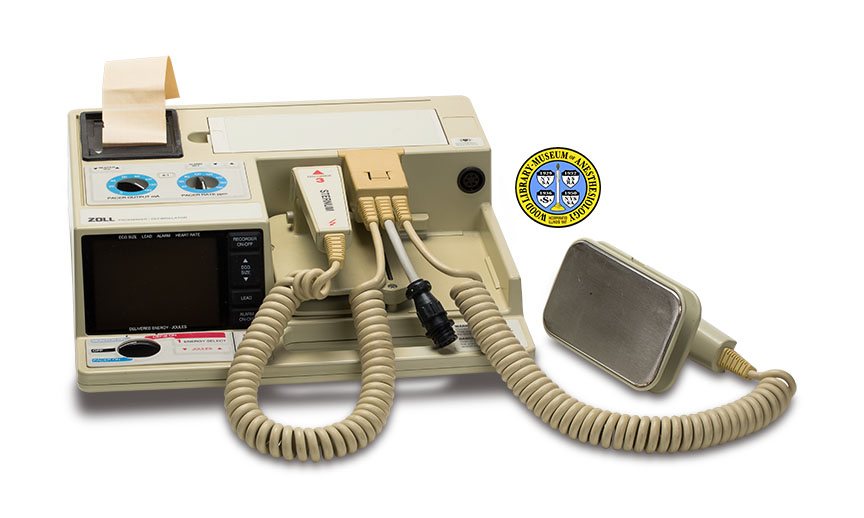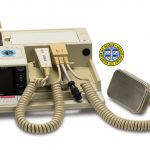Zoll PD-1400 Pacemaker-Defibrillator
Anesthesiologists are responsible for maintaining the patient's vital functions during surgery. This includes monitoring the heart, and performing cardiac resuscitation when necessary. The American cardiologist, Paul M. Zoll, M.D. (1911-1999) pioneered both electrical cardiac resuscitation and cardiac monitoring devices. In 1952, he described a method for resuscitating patients by reorganizing the heart rhythm (defibrillation.) In 1956, he and his colleagues developed a cardiac monitor that included a visual display and an audible alarm. He developed the implanted electric pacemaker in 1964.
Zoll Medical Instruments was founded in 1980. Pictured here is an example of the company's combined portable pacemaker, monitor and defibrillator, the PD-1400. Introduced in 1992, it was the most lightweight unit then available, designed for "critical patient transport and pre-hospital treatment" by medical professionals and paramedics. The company's first Automated External Defibrillator (AED) was approved just two years later. Today, AEDs are designed for use by the layman, and can be found in many public places.
Catalog Record: Zoll PD-1400 Pacemaker-Defibrillator
Access Key: amep
Accession No.: 1992-12-18-1
Title: Zoll Pacemaker/Defibrillator.
Title variation: Alt Title
Title: Zoll PD 1400 Pacemaker/Defibrillator.
Publisher: Woburn, Mass. : Zoll Medical Instruments Corporation, [1991?].
Physical Descript: 1 defilbrillator/pacemaker : plastics, metals, paper ; 11 x 33 x 31 cm.
Subject: Defibrillators.
Subject: Pacemaker, Artificial – instrumentation.
Subject: Cardiopulmonary Resuscitation – instrumentation.
Subject: Monitoring, Physiologic – instrumentation.
Subject: Zoll, Paul M. (Maurice), 1911-1999.
Note Type: General
Notes: The model PD 1400 was introduced in 1992. The label inside the battery pack
compartment states this is a demonstration unit. The label on the battery
pack itself states that it was tested in December, 1991.
Note Type: Citation
Notes: Zoll, PM. The first successful external cardiac stimulation and a-c
defibrillation. In: Safar PJ, Elam, JO. Advances in Cardiopulmonary
Resuscitation. New York, NY: Springer,1977:281-285.
Note Type: Citation
Notes: Cohen, SI. Paul M. Zoll – The father of ‘modern’ electotherapy and innovator
of pharmacotherapy for life-threatening cardiac arrhythmias. Resuscitation.
2007;73(2):178-185.
Note Type: Citation
Notes: Zoll PD 1400 Pacemaker/Defibrillator: Operator’s Guide. MEQL.com. https://www.
meql.com/Manuals/Zoll-1400-Ops-Manual.pdf. Accessed September 23, 2015.
Note Type: Citation
Notes: Other defibrillator models. Zoll. website. https://www.zoll.
com/medical-products/defibrillators/earlier-models/. Accessed September 23,
2015.
Note Type: Citation
Notes: Milestones in history. Zoll website. https://www.zoll.
com/about-zoll/corporate-milestones/. Acccessed September 23, 2015.
Note Type: Physical Description
Notes: One pacemaker/defibrillator; The case of the device is made of putty-colored
plastic ; This description views the device from the front while it rests on
a flat surface; The base of the device is shaped so that a portion extends
beyond the bulk of the device; This portion of the base has an oblong opening
to the right of center; the opening functions as a handle for carrying the
device in a vertical orientation; When horizontal, the portion of the base
which holds the handle extends forward;
To the left of the handle, a panel set into this portion of the base holds
the following controls: one dial with the settings “Pacer On”, “Off”,
“Monitor On”, and “Defib On”, as well as four push-buttons marked “1 Energy
Select”, “Joules”, “2 Charge” and “Sync”;
To the right of the handle there is an adhesive label stating: “WARNING [new
line] Hazardous electrical output. [new line] This equipment is for use only
[new line] by qualified medical personnel. [new line] DANGER [new line] Risk
of explosion if used in [new line] the presence of flammable [new line]
anesthetics.”;
The underside of the base has a round rubber “foot” in each corner; The top
of the device holds the rest of the components:
1) On the left, at the forward edge of the device and directly above the
control panel in the base, there is an upright monitor screen controlled by
four push-buttons; These buttons are marked “Recorder On-Off”, “ECG Size”,
“Lead” and “Alarm On-Off”; The monitor displayed heart rate,
electrocardiogram size, pacemaker output expressed in milliamps,
defibrillator output expressed in joules, the type of lead selected (e.g,
paddles, electrodes), and other operational prompts, messages and diagnostic
codes;
2) In the horizontal surface on top of this screen a panel holds two dials;
The dial on the left is marked “Pacer Output ma”, with settings marked in
twenty-degree increments from 0 to 120; Behind this dial is a push button
marked “Beeper Vol”; The dial on the right is marked “Pacer Rate ppm”, with
settings marked in twenty-degree increments from 40 to 180; Behind this dial
are three push buttons marked “Alarm Set”, [Upward arrow] and [Downward
arrow]; In between the two dials is a push button marked “4:1”;
3) Behind the “Pacer” control dials is a compartment that holds a roll of
graph paper (5 cm wide); All that is accessible to the user is a slot from
which the graph paper emerges; This component, called a “strip chart
recorder” functions automatically when the defibrillator is used and when the
alarm is triggered; The recorder can also be turned on and off manually…
[continued]
Note Type: Physical Description
Notes: [continuation] … 4) To the right of the paper compartment is a larger
compartment that holds the removable “Battery Pack”; The pack is enclosed in
a plastic housing; On the back of this housing is an adhesive label stating:
“Zoll Battery Pack [new line] Part No. 1004-0009 [new line] Use only with
Zoll PD1400 model series. [new line] Charge only in Zoll Battery Charger [new
line] (Part No. 1004-0015) [new line] Do not damage, crush or make structural
changes to this battery pack. [new line] Test Date [handwritten:] “12-25-91”
[new line] Made in U.S.A. by ZMI Corporation [new line] Woburn, Massachusetts
01801 [new line] U.S.A.”;
Inside the compartment that holds the battery pack, a label reads: “ZOLL
Model PD 1400 Serial No. 008 [new line] Federal (U. S. A.) law restricts
this device to sale by or on the order of a physician. [new line] This
equipment is manufactured under the following patents: [new line] U. S. # 4,
349,030 Canada # 1,179,740 [new line] France # 2,517,975 U.K. # 2,110,935
[new line] Other patents pending. [new line] Fabrique aux Etats Units
d’Amerique [new line] Made in U. S. A. by ZMI Corporation [new line]
Demonstration Unit [new line] Not For Clinical Use”.;
5) Below and in front of the battery pack, and to the right of the monitor,
is a horizontal dock that holds two defibrillator paddles; These paddles
slide in and out of closely fitted slots; The paddle on the left is marked
“Discharge 3” and “Sternum”; the paddle on the right is marked “Discharge 3”
and “Apex”; Each paddle is connected by a heavy spiral cord to an electrical
component set between the paddles; This electrical component also holds a
third cord which ends in a “female” connector;
6) Behind and above the right-hand (Apex) paddle, an outlet is set into the
housing; On the top of the device, immediately above this outlet, there is a
label that reads: “Electrically Isolated ECG”;
The WLM does not own an example of the battery charger nor any associated
loose cords.
Note Type: Reproduction
Notes: Photographed for the WLM by Mr. Steve Donisch on January 12, 2015.
Note Type: Acquisition
Notes: The manufacturer donated the unit to the Wood Library-Museum in December,
1992.
Note Type: Historical
Notes: Anesthesiologists are responsible for maintaining the patient’s vital functions during surgery. This includes monitoring the heart, and performing cardiac resuscitation when necessary. The American cardiologist, Paul M. Zoll, M.D. (1911-1999) pioneered both electrical cardiac resuscitation and cardiac monitoring devices. In 1952, he described a method for resuscitating patients by reorganizing the heart rhythm (defibrillation.) In 1956, he and his colleagues developed a cardiac monitor that included a visual display and an audible alarm. He developed the implanted electric pacemaker in 1964.
Zoll Medical Instruments was founded in 1980. Pictured here is an example of the company’s combined portable pacemaker, monitor and defibrillator, the PD-1400. Introduced in 1992, it was the most lightweight unit then available, designed for “critical patient transport and pre-hospital treatment” by medical professionals and paramedics. The company’s first Automated External Defibrillator (AED) was approved just two years later. Today, AEDs are designed for use by the layman, and can be found in many public places.
Note Type: Exhibition
Notes: Selected for the WLM website (Noted September 23, 2015).


